When the Indian Army Wednesday denied BJP MP Tapir Gao’s claim that China was intruding into the Chaglagam and Bishing area of Arunachal Pradesh, I decided to look for anything that might hold as evidence of intrusion. I found no discernible evidence of intrusion in the Chaglagam region of the state. However, based on help from various open-source intelligence, or OSINT, handles, what we ended up detecting is far more serious: not only have the Chinese intruded in the northern region at Bishing about 175 km from Chaglagam, but they have also built a road approximately 1 kilometre deep into the Indian side of the Line of Actual Control. This road enters from the east where the border runs north-south, and runs parallel to the east-west orientation of the border.

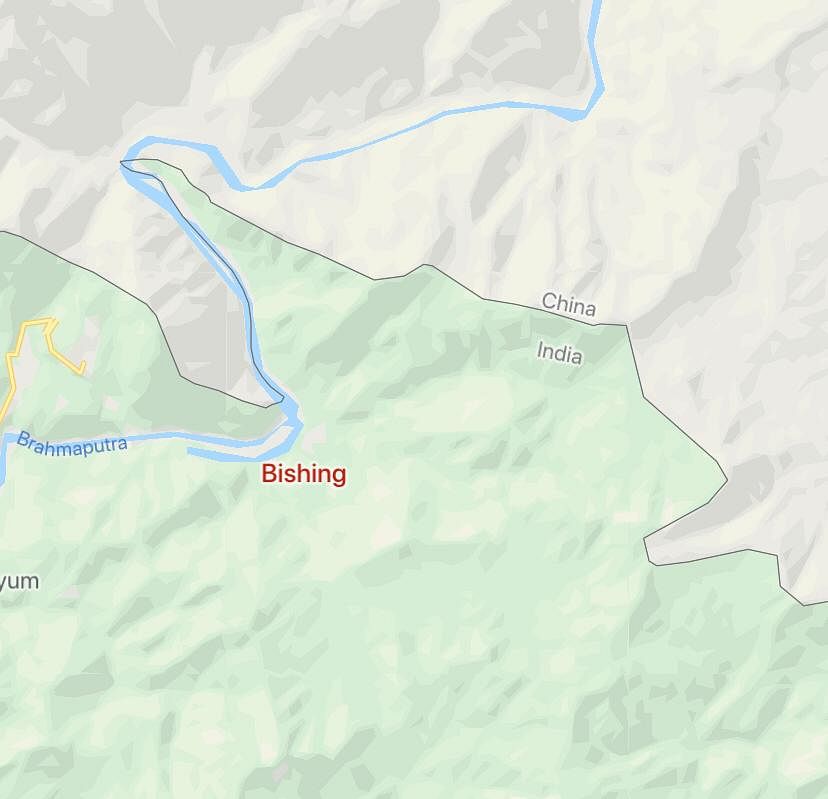
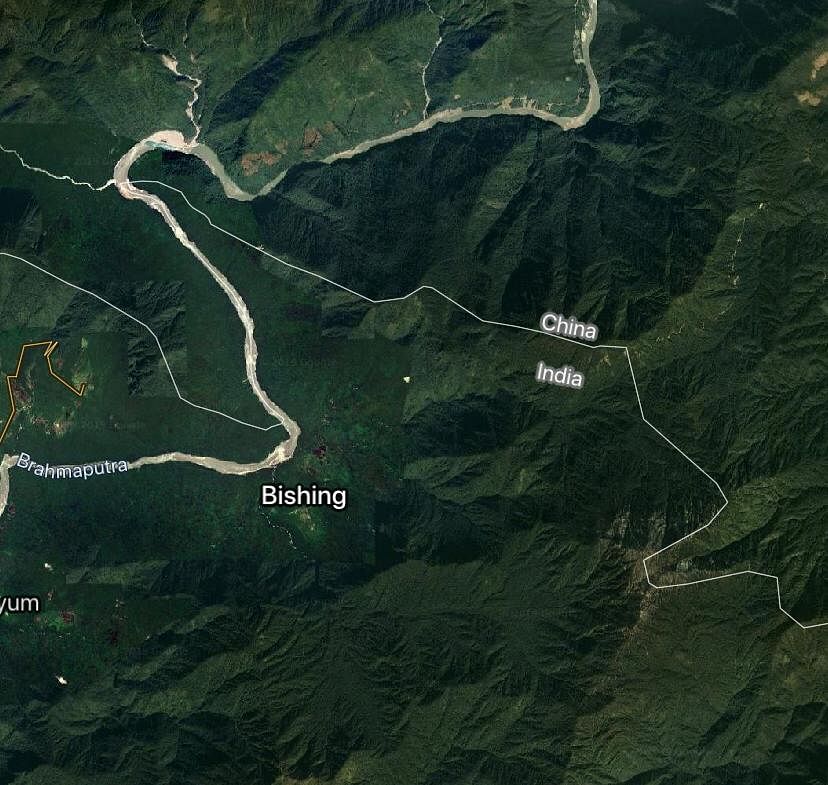

Images 1 to 4 show the general location of the areas we are speaking about: Chaglagam, where we were not able to establish any specific incursion has the red marker, and the grey marker on the top shows the Bishing salient on the Brahmaputra, west of the Dibang Wildlife Sanctuary.

Image 5 shows the distance between the incursion point at Bishing and Chaglagam, which was also part of the MP’s claim, and the incursion point’s relative position to the Dibang Sanctuary.


Using Google’s native measurement tool, image 6 shows the road, running from east to west, is 942 meters deep into the Indian territory and runs parallel to the border at an almost consistent depth of 300 to 400 meters (image 7).

Image 8 shows the topography of the region. The thin trail is visible starting south of Degangsi, while the red marked box can be further expanded into Image 9 (below).

Image 9 shows the thin road entering India just where the border switches from west-east to north-south running parallel to a valley. It may be noted that trade opportunities here are non-existent given the absence of a joining road from the Indian side. This leads to a high probability that the road construction project is about creating facts on the ground.
What are “facts on the ground”? Basically when a border is disputed, the creation of population centres or infrastructure essentially forces a border to be redrawn. Assume for example that China agreed in 2015 that the LAC as is was the border, the fact that they have created infrastructure 1km west and 300 meters south into Indian territory, while India has nothing in the region, would mean that China will essentially insist the LAC be moved south of its constructed infrastructure. This is how Israel also lays claim to much of the West Bank — by creating infrastructure (and population centres) to muddy the border. The question is, what could these facts on the ground portend?

There are three possibilities as shown in image 10 above.
1: This could mean a southwards annexation from the east-west border orientation to gobble up the entire valley until it meets the plain further west (marked by the red line)
2: It could mean establishing further claim on the hill ridge just south of the road and also up to the point where it tapers down into the Brahmaputra plain (marked by a dotted blue line)
3: Maximally, it could mean a full extension up to the Brahmaputra to completely cut off this salient (two possibilities marked in light pink – The first possibility is the road itself is treated as the border and is extended up to the Brahmaputra at the point shown – that is to say an extension of the red line. The second possibility (flowing from option 2 above – China claiming the mountain ridge south of its road as the border) is that it draws the line from the end of the mountain ridge to the Brahmaputra; that is to say as an extension of the blue dotted line.
Note: In this particular salient, the border is the Brahmaputra marked in light orange.

As image 11 above shows, at worst we could be looking at a loss of an entire salient that juts into China as shown. Given the seriousness of the situation, we decided to purchase high-resolution imagery and analyse the time-series imagery to confirm the road was in fact constructed by the Chinese. The results were startling.
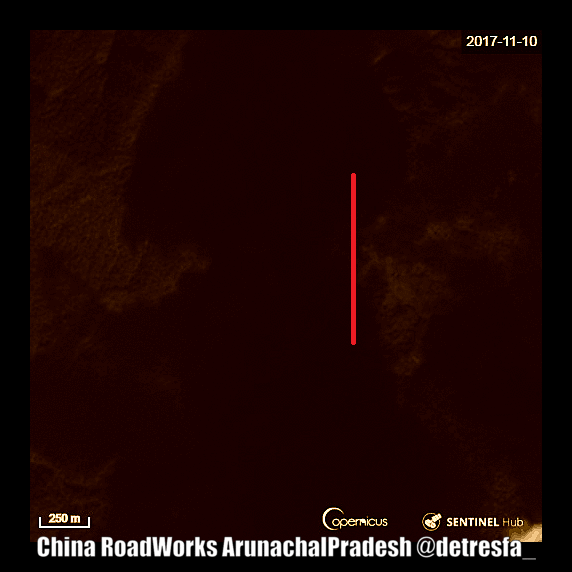
Starting in 2017, this animation (image 12) shows a clear westwards expansion originating from China (the red line marks the border). What is significant about this road is that it is backed by significant infrastructure within China from its starting point on the Brahmaputra and virtually no infrastructure of note on the Indian side.

The major points of interest discernible on this road are that it has two possible military bases, two checkpoints, a clearing/gathering area and the final point of entry into India, which as of now are clearly inoperative given the depth of the intrusion (image 13). Below are the high-resolution images of each of these points of interest.

The first is a possible military base on the Brahmaputra (image 14). This shows some clearly developed infrastructure including car and truck fuel stations and construction. Noticeable is the complete lack of civilian presence, huts, etc. The reason we are convinced it is a military base is due to the sheer lack of civilian habitation around it, though it could equally be an innocent outpost, which is just not commercially viable.

Possible military base two on the other hand (image 15) is much more pronounced: the buildings are mostly large and administrative in nature with excellent quality construction and a significant human presence. Of particular note is the extensive and high perimeter wall separating an administrative area. Given the population outside this administrative area is not high (a hundred or so at most), the size of the buildings seems to indicate a military administrative outpost, built for scaled up operations, if and when desired.

Image 16 shows what we have labelled the North Checkpoint. The opening here has clearly been made much earlier. The greening of the clearing shows that there was not much human or vehicle movement here allowing the grass to grow back. Again, there is a solitary building here with a side road leading from and joining back onto the main road, presumably to not let the oncoming traffic block the main road.

The next point of interest related to the portion of the road still in China is a large artificial clearing (image 17). We are unable to determine the exact purpose of this clearing, given that even time series did not show the presence of construction equipment or camps. However, given the precipitation and rate of flora regrowth, the barrenness of this clearing is important, though we are unable to determine the exact reason, save the prolonged presence of humans and or vehicles.

The clearing leads to the “southern checkpoint” (image 18). Given its location atop a relative elevation (as can be seen in the inset), we suspect this to be more of an observation outpost than a checkpoint. The blue roofs are a clear indication of ownership (Indian installations use green corrugated iron while the Chinese use blue).

Finally, we come to the border (marked by the red dotted line). Note the complete lack of any Indian presence here in image 19: be it on the border or on the first clearing or the second clearing. As the time series animation in this article showed, these two clearings came up post 2017 clearly as an extension of the Chinese road. It is also important to note here that while the Chinese have expanded the road into Indian territory, they have not built any structure inside India. The road leading further west from the second, larger clearing on the left of the image above goes a further 200-500 metres, although we are unable to plot exactly how far.
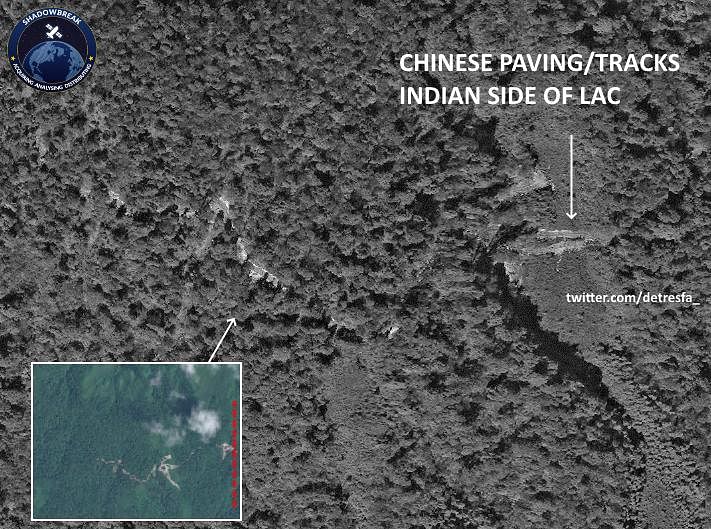
What we can say with absolute certainty is that even though we could not find bulldozers (MP Tapir Gao made a clear claim of bulldozers being used), we did find tell-tale marks (image 20) of bulldozer usage on the westernmost clearing on Indian soil. The east-west orientation of this bulldozer activity is in the same direction as the road that is proceeding further into India. At any rate, the use of some heavy earth moving equipment is obvious, and given there is no suitable access to this point from the Indian side, these bulldozers could have only come from China. This means the Chinese have used heavy earth moving equipment, possibly bulldozers, deep inside Indian territory.
The findings of Chinese intrusion deep into Indian territory, without any challenge or counter from the Indian side, is clear and unambiguous in the Bishing salient. The Chinese have entered at least 1 kilometre into Indian territory, constructed a motorable road using heavy earth moving equipment and all of this has been done systematically and persistently since 2017 at least, without any visible Indian opposition.
This clearly proves BJP MP Tapir Gao’s claim. It is therefore highly likely that his claims regarding an incursion into the Chaglagam sector could also be true. However, as of now, possible incursions in Chaglagam are neither visible to satellite nor backed up by a visible, motorable road or supporting infrastructure on the Chinese side of the border. What remains to be seen is how this situation develops and how it is countered, given the total lack of response from the Indian government to this alarming development since 2017.
Time series animation courtesy: @sentinel_hub and @CopernicusEU
High-resolution images courtesy: @sbreakintl and @detresfa_
The author is a senior fellow at the Institute of Peace and Conflict Studies. He tweets @iyervval. Views are personal.


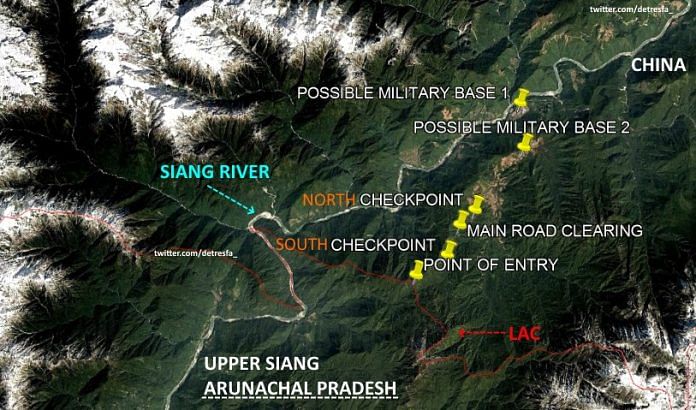

The author has now in this paper and many before has perpetuated falsehood. God knows what his intent is? We have confidence in Indian Army to resist forcefully any Chinese moves on the eastern or western border. Chinese know that at Doklam they were forced back. Same was true in Ladakh where physical contact with tiny Chinese solders by tall and tough Jats proved counter productive to them and their propaganda. Hence they would not attempt anything like what the author is saying.
The track was constructed by PLA in 2017 and was immediately resisted by IA . They withdrew to their side . A wall was constructed at the LAC by the IA and same is being respected by the PLA. Tree plantation has been done on the track constructed inside our territory. Please note it is inhospitable terrain with no settlement around and no surface communication on our side. Stop spreading histeria.
True. We have unity in diversity. South Indians, North Indians, Hindus, moslims, Buddhist, Jain’s, Dalits, parsis altogether. Different facials, races, religions,languages, castes, communitys still United as a Nation. It is possible only because of secularism. Once we abandon secularism and start dividing on religion, region, language it will be easy for Chinese or any external forces to divide Indian society and create unrest in the country. Instead of adopting minority bashing as vote bank politics address the issues of economy, technology, employment, agriculture , trade development as issues of politics.
Muslims/Islam Or Evangelists Giving Lessons On Secularism Is Like Demons Talking Of Human Welfare!! WHEN Will You Guys Look Within??!!
Old new man!
https://arunachaltimes.in/index.php/2018/01/06/aapsu-demands-proactive-response-on-intrusion-of-chinese-troops-in-arunachal/
https://arunachaltimes.in/index.php/2018/01/09/chinese-following-a-set-pattern/
When local Arunachalis report no one at national level takes it serious.
When some ‘defense expert’ reports it suddenly becomes ‘news’???
Common…
Another classic case of mis-information being spread by this government. George Orwell’s 1984 is proving to be all too true. You shall see what we ask you to see, you shall hear what we want you to hear and you shall read what we want to hear. But what they have not contended with is the amount of free information that is available to us. Had it not been so serious, it would be almost amusing to see what is unearthed once this government demits power, as it surely will.
Bjp made a strategic error in concentrating forces in Jammu Kashmir and leaving Aruchanl exposed, what else to expect from present dispensation hell bent on vendetta politics
CHINA ISSUES, CHINESE PASSPORTS TO CITIZENS OF AP ON APPLICATION IN CHINA
PEOPLE BORN IN AP DO NOT NEED A VISA TO VISIT CHINA
THIS IS WHY OUR SECULARISM IS IMPORTANT.
China has always considered AP part of its own territory. It considers AP people Chinese people.
People linguistically and ethnically here, have more in common with China , then people on the Hindi speaking belt in India .
What does a person of Tibetan ethnicity have in common with a saffron Sanghi in the Hindi Speaking belt? How on earth given his own Buddhist cultural heritage, can he identify with Hindutva.
The AP person is also very different from the Dravidian South Indian.
What binds him to India is the secular nature of the constitution, which embraces the ethnic and religious diversity of people in the region. Our secularism is what binds is.
The RSS philosophy of Akhand Bharat only applies to the culture of the Hindi speakers.
The BJP philosophy of Hindu supremacy will divide India, these are the tudke, tucks, gang.
We are all united as Indians in our diversity. Out secularism is the force that counters the centrifugal forces pulling us apart.
China has a lot to offer people of AP, a standard of living five times as high, non third world healthcare, and the best education in Asia. China will soon be the richest country in the world with the benefits that will bring to its people.
The only way to convince the ethnic Tibetan people that India is a better place than China is our secularism and democracy.
Hi Mukarram Ali Khan, why don’t you apply for a Chinese citizenship? You seem to be in awe with the atheist Chinese. You will definitely make your prophet proud. And the Chinese will definitely welcome you with open arms to their concentration camps in Xinjiang. Or you can migrate to Pakistan and enjoy being a muhajir, a second class citizen with practically no voice. If you have no other choice other than living with the Hindus and enjoy the freedom that India provides, then learn to respect Hindus and shut it. That’s the most secular thing you can do!
Grass is Green – be honest, do you believe in your own BS? BTW, ‘Muhajirs’ dominate Pakistan alot, Gen. Zia, Gen Mush etc were Urdu speakers.
We Have Seen ‘Muhajirs’ dominate Pakistan ONLY From London!! Watch ‘Muhajir’, Altaf Hussain, MQM
Founder leader on Kashmir & Other Issues:
https://www.youtube.com/watch?v=XPzOTeel4Ss&t=56sel4Ss&t=56s
You are only an ignorant `RSS `bhakt with an inferiority complex, you curse Mukarram Khan In the most communal manner. With some education you will be able to appreciate what he is saying.
As for your childish talk of go to Pakistan to Muslims, what have you done for India yourself?
,Mukarram Khans Ancestors give India it’s beautiful culture, language and food. Look around you at the ancient monuments around you, build by his ancestors while yours defecated in the fields.
Get yourself a life and education you ignorant communal troll.
India belongs to all its citizens not only Hindus,
I can say as a Hindu you are a disgrace to our religion.
Lol!! And Those Smart Muslims Rulers Of Intelligent Islam NEVER Built A University!! WHY?? Everything Is In The Quran!! Any More Jokes On Muslim Rulers & Islam’s Contribution To India & Humanity??!!
Muslims/Islam Or Evangelists Giving Lessons On Secularism Is Like Demons Talking Of Human Welfare!!
Muslims/Islam Or Evangelists Giving Lessons On Secularism Is Like Demons Talking Of Human Welfare!! WHEN Will You Guys Look Within??!!
I think you’re ignoring some of the obvious here. so let me point it out. China’s growth has been staggering but not all is as it looks on the surface and not all that glitters is gold.
Contrary to your assumptions, China is not culturally seductive to the it claims to be ethnically Chinese from all over the world. More people go to China for economic reasons that cultural ones and modern China is bound by a common market and recognition of the proletariat as the identity of China vis a vie the CCP. Although China may package Tibet and the Forbidden City for foreign tourists it urged it’s members to destroy their Buddhist heritage (art, manuscripts etc) as a commitment to the industrialization and development of China. A person of Chinese origin from rural India, or even developed parts of the world like Taiwan may today find it difficult to adjust to the high demands of working in China.
Anyone considering moving to China has to take many practical considerations into account. Cantonese and Mandarin differ from each other about as much as Hindi and Tamil.
As for AP, when you point out “People linguistically and ethnically here, have more in common with China , then people on the Hindi speaking belt in India .”, that maybe true but those cannot be in the real world the only incentives for people to capitulate any self-government or ambitions on a global stage.
And finally is it not the case that the Pakistanis say that they came from the Ghaznavid empire and have more in common with Iran and Arabic culture “linguistically and ethnically” speaking. If we extend you logic of of the possible outcomes of BJP on AP, to their influence on Pakistan then how possible do you think it will be that a failing state like pakistan will dissolve itself, and it’s sovereignty and historical (albeit short-lived) existance and become another province is Iran and Saudi Arabia. Is it possible, by your logic, that Iran and K.S.A can chop up Pakistan amongst themselves and after all Pak had nothing “linguistically” and “ethnically” (and ideologicall i may add) common with India.
Sorry but that’s not how the real world works.
“The only way to convince the ethnic Tibetan people that India is a better place than China is our secularism and democracy.” – I’m sorry but this is just silly thinking, people are not tools that can be remodeled by propoganda and persuation and need to be constantly cajoled. They have agency, culture ambitions and the desire to progress. The relationship between governments and people has always been contractual – sometime consensual and most of the time not so. Even if we convince Jews, Tibetans, Drazais, Ahmediyas, or any Indian for that matter of the tolerance and other Nehruvian values of India, they will still leave if they realize that they can live better lives elsewhere and have better opportunity to improve their lot and be of service to their families and children elsewhere. At the enfd of the day people make life choices based on family, children, ambition, desire and needs, not on vauge ideas of ethnic or linguistic commonality are these are never set in stone.
Julius Caesar built a bridge across Rhine to demonstrate to the Germanic tribes that the Romans could easily and at will cross the Rhine and conquer their lands. Caesar could have easily crossed the river by boat, but he chose to build the bridge to demonstrate the Roman’s willingness to bring the fight to the enemy.
Chinese are doing exactly the same thing by building a road using mechanized equipment and a bridge (https://youtu.be/4YyDF7srP7o) deep inside India to show that they are not bothered about the Indian military and they’re quite willing to stake their claims on the ground by bringing the fight to the Indians. This might be a concerted effort from both Pakistan and China to pull India into a two-front war and grab as much acreage as they can (Recall the Chinese military leadership’s recent visit to Pakistan) in the process.
The strategy seems to be working as the meek Indian army is busy silencing the internal warnings from AP leaders instead of actually confronting the Chinese at the border.
You can defeat a bully only by standing up to him, not by polite prayers.
Good capture these roads on the Indian side of LAC and drive the useless Chinese out.
Our propaganda of We are doing this and that are more, Valor Martyred and Medals, Honestly In NE India each and every Army Jawans , officers are paid Extra 10 to 50 k for working here apart from the salary . Secondly each of Post are deep inside the jungle and getting there takes days of Hiking or Helidrop. From one post to another there is miles apart an terrain is not consumable for any daily Gasth,…..Officers and High ups Knows every details of any Movements but………its the decision of Action where Problems starts
Regards..
Time to show them Red Red eyes.
Nice joke but I dont think you fall in the bhakt category